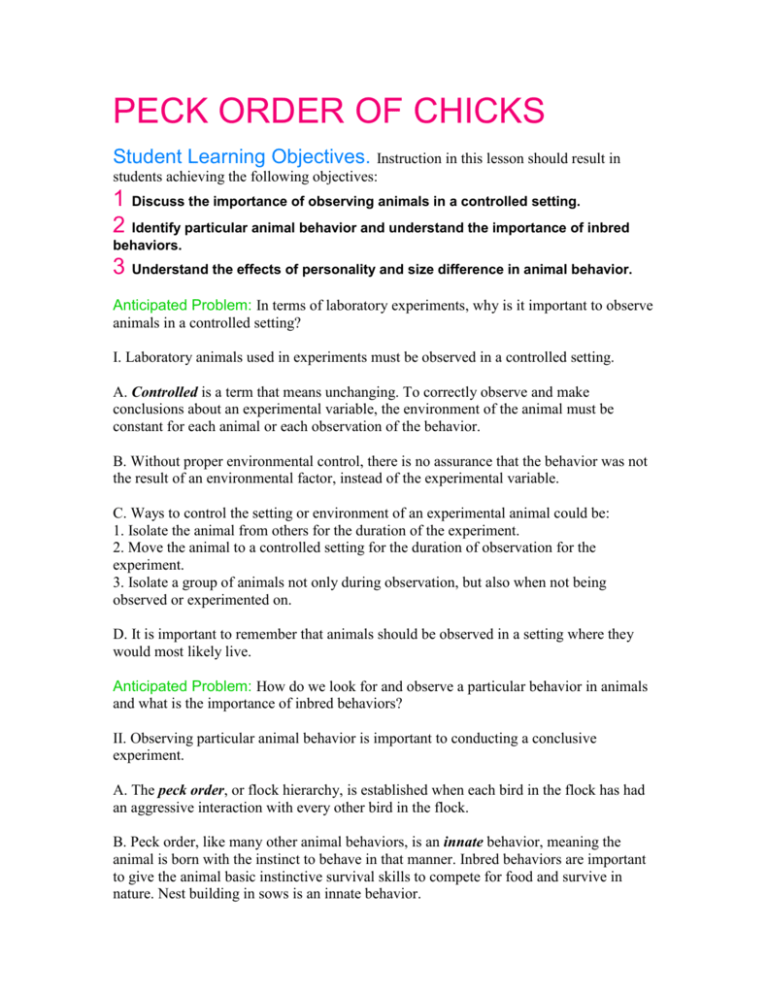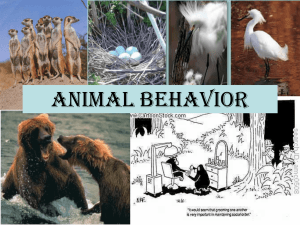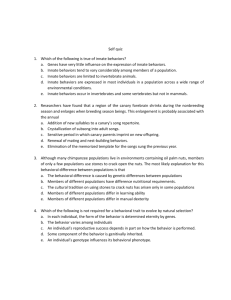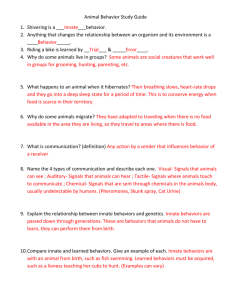bsaa peck order of chicks worksheet
advertisement

PECK ORDER OF CHICKS Illinois Biological Science Applications in Agriculture Lesson C2–4 • Page 1 Student Learning Objectives. Instruction in this lesson should result in students achieving the following objectives: 1 Discuss the importance of observing animals in a controlled setting. 2 Identify particular animal behavior and understand the importance of inbred behaviors. 3 Understand the effects of personality and size difference in animal behavior. Anticipated Problem: In terms of laboratory experiments, why is it important to observe animals in a controlled setting? I. Laboratory animals used in experiments must be observed in a controlled setting. A. Controlled is a term that means unchanging. To correctly observe and make conclusions about an experimental variable, the environment of the animal must be constant for each animal or each observation of the behavior. B. Without proper environmental control, there is no assurance that the behavior was not the result of an environmental factor, instead of the experimental variable. C. Ways to control the setting or environment of an experimental animal could be: 1. Isolate the animal from others for the duration of the experiment. 2. Move the animal to a controlled setting for the duration of observation for the experiment. 3. Isolate a group of animals not only during observation, but also when not being observed or experimented on. D. It is important to remember that animals should be observed in a setting where they would most likely live. Anticipated Problem: How do we look for and observe a particular behavior in animals and what is the importance of inbred behaviors? II. Observing particular animal behavior is important to conducting a conclusive experiment. A. The peck order, or flock hierarchy, is established when each bird in the flock has had an aggressive interaction with every other bird in the flock. B. Peck order, like many other animal behaviors, is an innate behavior, meaning the animal is born with the instinct to behave in that manner. Inbred behaviors are important to give the animal basic instinctive survival skills to compete for food and survive in nature. Nest building in sows is an innate behavior. C. Behavior in animals can be learned as well as innate. Learned behaviors are ones that the animal was not born with, but learned over time. Pavlov’s dog experiment caused dogs to salivate at the sound of a bell because they associated the bell with being fed. Eventually, the dogs would salivate when they heard the bell, whether there was food present or not. This is an example of a learned behavior, known as association, in animals. Anticipated Problem: What effect does personality and size difference have in animal behavior? III. Much of an animal’s behavior is influenced by territory and intrusion into territory by another animal. A. Dominant, or more socially aggressive birds are usually found at the top of the social hierarchy of the flock. Submissive, or socially shy birds are usually found at the bottom of the flock hierarchy. B. The top bird in the flock is referred to as the alpha animal. C. Animals that are highest ranked in the peck order generally get first chance at feed and therefore are the healthiest birds in the flock. Once rank is established, the birds will fight less and have more time to spend eating. Stress levels also decrease with higher positions in the hierarchy. Overall, the higher the rank of the bird, the healthier the bird will be overall. Illinois Biological Science Applications in Agriculture Lesson C2–4 • Page 4 PECK ORDER OF CHICKS Part One: Matching Instructions: Match the term with the correct response. a. dominant b. peck order c. submissive d. learned e. innate f. controlled g. alpha animal _______1. Top animal in the social hierarchy. _______2. A behavior that the animal acquires through experience. _______3. A behavior that can be described as “shy.” _______4. Behavior that the animal is born with. _______5. An animal that is socially aggressive or overpowering. _______6. The ranking of chicks in a flock due to aggressive interactions. _______7. An environment that is unchanging. Part Two: Completion Instructions: Provide the word or words to complete the following statements. 1. Higher rankings in the peck order cause __________ levels to decrease. 2. One way to control the environment of experimental animals is to __________, or separate the animal from others for the duration of the experiment. 3. Most of an animal’s behavior is influenced by intrusion into its ______________. Illinois Biological Science Applications in Agriculture Lesson C2–4 • Page 7 Part Three: Multiple Choice Instructions: Circle the letter of the correct answer. _______1. An alpha animal is the most: a. submissive b. aggressive c. social d. unhealthy _______2. What behavior can an animal be taught or trained? a. innate b. learned c. social d. genetic _______3. An animal at the bottom of the peck order will most likely be: a. aggressive b. healthy c. unhealthy d. not stressed _______4. What type of behavior is nest building in sows? a. habituation b. innate behavior c. association d. learned behavior _______5. When the feed auger turns on, the cattle run to the feeders. This is an example of what behavior? a. innate behavior b. association c. instinctive behavior d. trial & error Part Four: Short Answer Instructions: Provide information to answer the following statements. 1. Explain why innate behaviors are important to an animal’s survival in nature. 2. Briefly describe the benefits of being the top ranking chick in a flock. Illinois Biological Science Applications in Agriculture Lesson C2–4 • Page 8 Assessment TS–A Technical Supplement PECK ORDER OF CHICKS 1. Where do the behaviors of domesticated animals come from? The capacity for behaviors in an animal is determined by the animals “anatomy and physiology.” Thus, the ability for an animal to exhibit certain behaviors is inherited. Within the boundaries of an animal’s anatomical and physiological characteristics, given behaviors are either instinctive (innate) or learned, and are usually a reaction to some type of stimulus. 2. What is the best way for scientists to observe a particular behavior? Particular behaviors are best observed if animals are placed in a setting which is “normal” to them, and they are provided with the proper stimulus to cause a response or “behavior.” 3. What is the difference between innate and learned behaviors? “Innate” behavior is often referred to as “instinctive” behavior. A stimulus triggers a fixed response that does not vary according to the circumstances. This type of behavior is very dominant in animals of lower intelligence and is a type of behavior that animals have very little self control over (i.e., insects flying toward light). “Learned” behavior is a modification of behavior as a result of experience. It becomes more pronounced in species which have a greater ability to “learn” from experiences. These animals usually have a more complex nervous system which monitors more senses and thus gives the animal more information to process and learn from. Often animals with a greater “inherited” ability to learn will also have a greater ability to survive and reproduce since they can learn the behaviors that will provide for their survival. Illinois Biological Science Applications in Agriculture Lesson C2–4 • Page 19 4. How can the behavior of an animal be altered? Behavior can be altered in many ways. Innate behaviors usually show the least degree of change, but change can occur if environmental stimuli are altered, creating a new situation to which the individual must adjust. Only animals capable of making such a behavioral adjustment will be able to survive. The inability to adjust has led to the extinction of many species. The most common means of altering “learned” behavior are, “habituation, association, and trial & error (operant learning).” “Habituation” will cause an animal to cease with a particular behavior in response to a stimulus if the expected outcome is not realized. Tame animals have learned not to be fearful of man. Through “association” animals may learn to give a response to an irrelevant stimulus. Pavlov’s dogs learned to expect food and began to salivate when a bell rang because they had learned to associate the ringing of the bell with food. “Trial & error” learning occurs when animals are faced with several alternative choices and are rewarded for making correct choices, and in some instances, are punished for making wrong choices. Most authorities believe that it is more important to reward good behavior than to punish the wrong. Why would this be important? It is important that animals learn to adjust their behavior when placed in a changed environment, if they are to survive. The theory of natural selection would suggest that animals that have the greatest ability to learn and adjust to new situations would be the ones most likely to survive and reproduce. From a societal or economic perspective, the ability to adjust animal behavior has allowed man to capitalize on animal resources for power, food, by-products, and companionship. 5. What is the impact of changing the behavior of wild and domesticated animals? Changing the behavior of wild animals has made many of our domesticated animals incapable of fending for themselves in the wild. Behaviors for survival which were patterned from parent to offspring are lost. Certain behaviors which are innate to a species (such as the nesting habit of sows) have survived. Changing the behavior of animals has allowed the animals to be produced more efficiently due to reduced stress once the behavior is adjusted and accepted. Illinois Biological Science Applications in Agriculture Lesson C2–4 • Page 20 6. What effects could an animal rank in a social order have on its overall health? An animal’s rank in the social order is directly related to its strength, health, and disposition. The composite of these traits will directly affect its ability to remain healthy due to the fact that the dominant animal with the highest rank will have the most food to eat and will usually be able to force its way into the best shelter if needed. These animals are usually the strongest and most apt to survive. This strength and longevity will provide the greatest opportunity for the animal to reproduce and perpetuate its positive genetic traits. Illinois Biological Science Applications in Agriculture Lesson C2–4 • Page 21







